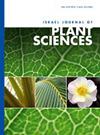Evaluation of sorghum genotypes for their reaction to major grain molds and mycotoxin-producing fungi in two climates of Ethiopia
IF 0.9
4区 生物学
Q4 PLANT SCIENCES
引用次数: 0
Abstract
Use of resistant genotype is considered to be the most feasible means to mitigate sorghum grain damage by grain mold in a climate favourable for fungal invasion and subsequent mycotoxin contamination. Field-based experiments were conducted at Babile and Haramaya for two consecutive cropping seasons to evaluate 20 sorghum genotypes for their reaction to grain molds as well as aflatoxin and fumonisin contamination. Aspergillus flavus and Fusarium verticillioides with spore concentrations of 106 ml-1 were inoculated by spraying into the inflorescence, when the anther emerged from approximately 50–70% of the spikelets. Mycotoxin analysis was done using enzyme-linked immunosorbent assay (ELISA). The results revealed that the sorghum genotypes evaluated for their reactions to A. flavus and F. verticillioides inoculation had significantly different responses. Variety Melkam was identified as a susceptible genotype to F. verticillioides and variety Birhan was found resistant to both fungal species. Variety Long Muyera was the most susceptible to both toxigenic fungi. Long Muyera was contaminated with aflatoxin B1 and total fumonisin above the maximum tolerable limit of 10 µg kg-1 and 2000 µg kg-1, respectively. Though the sorghum genotype Birhan was resistant to A. flavus, its aflatoxin B1 contamination was relatively high. In this study, it was recognized that none of the tested sorghum genotypes exhibited possession of multiple resistance to the inoculated toxigenic fungi. Therefore, it is commendable to select and use genotypes, which are resistant to specific toxigenic fungi for a particular location, where the problem exists.埃塞俄比亚两种气候条件下高粱基因型对主要谷物霉菌和产霉菌毒素真菌反应的评价
在有利于真菌入侵和霉菌毒素污染的气候条件下,利用抗性基因型被认为是减轻高粱籽粒霉菌危害的最可行手段。在Babile和Haramaya进行了连续两个种植季的田间试验,以评估20种高粱基因型对谷物霉菌以及黄曲霉毒素和伏马菌素污染的反应。孢子浓度为106 ml-1的黄曲霉和黄萎病镰刀菌,在约50-70%的小穗花药出花药时喷施于花序。采用酶联免疫吸附法(ELISA)进行霉菌毒素分析。结果表明,不同高粱基因型对黄曲霉和黄曲霉接种的反应差异显著。品种Melkam被鉴定为对黄萎病真菌敏感的基因型,品种Birhan对这两种真菌都有抗性。品种龙木莱拉对这两种产毒真菌最敏感。龙木耶拉的黄曲霉毒素B1和总伏马毒素含量分别超过最大可耐受限值10µg kg-1和2000µg kg-1。高粱基因型虽然对黄曲霉有抗性,但其黄曲霉毒素B1污染较高。在本研究中,没有一种高粱基因型对接种的产毒真菌具有多重抗性。因此,选择和使用对问题存在的特定位置的特定产毒真菌具有抗性的基因型是值得称赞的。
本文章由计算机程序翻译,如有差异,请以英文原文为准。
求助全文
约1分钟内获得全文
求助全文
来源期刊

Israel Journal of Plant Sciences
生物-植物科学
CiteScore
1.90
自引率
0.00%
发文量
17
审稿时长
>12 weeks
期刊介绍:
The Israel Journal of Plant Sciences is an international journal of extensive scope that publishes special issues dealing with all aspects of plant sciences, including but not limited to: physiology, cell biology, development, botany, genetic
 求助内容:
求助内容: 应助结果提醒方式:
应助结果提醒方式:


